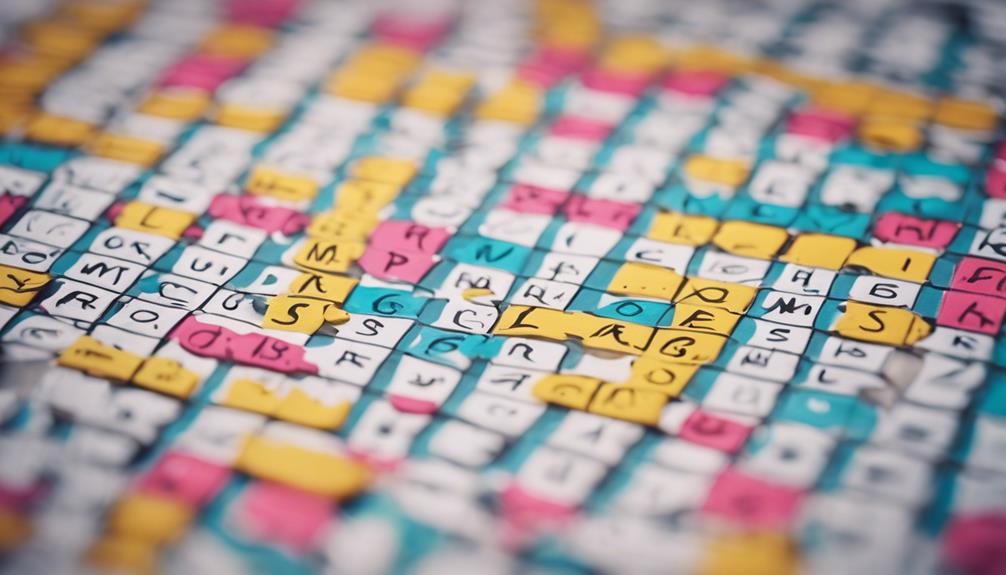When it comes to crafting word search puzzles, remember that 'practice makes perfect.'
Have you ever wondered about the intricate balance between artistry and scientific precision that goes into creating these mind-teasing games?
The fusion of selecting just the right words, structuring the grid layout, and imbuing clues with a touch of intrigue holds the key to crafting engaging puzzles.
But there's more to it than meets the eye.
🌊 Discover Endless Fun with Beachcomber Press Puzzle Books! 🌊
Elevate your puzzle game with our captivating collection on Amazon.
Perfect for all ages, our books are packed with unique
challenges that promise hours of entertainment.
Diverse puzzles for every skill level High-quality, engaging content
Stay tuned to uncover the fascinating world behind the scenes of word search puzzle creation.
Key Takeaways
- Effective word choices and grid patterns enhance puzzle engagement.
- Craft interactive clues for immersive solving experiences.
- Varying difficulty levels cater to diverse solver skills.
- Theme development and feedback utilization drive innovative puzzle design.
Selecting the Right Words

When creating a word search puzzle, you must carefully choose the words that will engage and challenge the solver. Effective word choices are crucial in making your puzzle enjoyable and stimulating. To do this, consider various word selection techniques to ensure that your puzzle is both entertaining and intellectually rewarding.
Vocabulary considerations play a significant role in word list curation. It's essential to strike a balance between common and uncommon words to cater to a diverse audience. Including a mix of easy, moderate, and difficult words can provide a satisfying challenge for solvers of different skill levels. Additionally, incorporating thematic words related to a specific topic can add depth and coherence to the puzzle, enhancing the overall solving experience.
Crafting the Grid Layout
To ensure an engaging and well-structured word search puzzle, strategically designing the grid layout is key in enhancing your experience and maintaining the challenge level set by the chosen words. When crafting the grid layout, consider the following:
- Grid Patterns: Experiment with different grid patterns to keep the solver intrigued. Circular or spiral layouts can add a unique twist to the traditional word search format, making it more visually appealing and mentally stimulating.
- Word Placement: Carefully place words within the grid to maximize the puzzle's difficulty. Scatter words in varying directions, overlapping some letters to increase complexity. This strategic placement ensures that solvers must pay close attention to detail and think critically to uncover all the hidden words.
- Challenge Balance: Strike a balance between grid patterns and word placement to maintain an optimal level of challenge. Too many complex patterns or overly intricate word placements can frustrate solvers, while excessively simple layouts may lead to boredom. Finding the sweet spot will keep solvers engaged and satisfied with the puzzle's difficulty level.
Designing Clues for Engagement

How can you craft clues that captivate and engage solvers in a challenging word search puzzle? To enhance player interaction and create an immersive experience, consider designing interactive clues that prompt solvers to think creatively and engage with the puzzle in a dynamic way. Interactive clues can range from riddles and trivia questions to visual cues or cryptic hints that require critical thinking. By incorporating such elements, you not only challenge the solver's cognitive skills but also add an element of fun and excitement to the puzzle-solving process.
To illustrate the concept of interactive clues, let's delve into the following table that showcases different types of engaging clues:
| Clue Type | Description | Example |
|---|---|---|
| Riddle | Puzzling question or statement that requires creative thinking | "I speak without a mouth and hear without ears. I have no body, but I come alive with the wind. What am I?" |
| Trivia Question | Fact-based question that tests knowledge and adds an educational aspect | "Which planet is known as the Red Planet?" |
| Visual Cue | Image or symbol that hints at the hidden word |  |
Understanding Difficulty Levels
Crafting word search puzzles with varying levels of difficulty is essential to cater to a wide range of solvers' skills and preferences. Understanding the nuances of difficulty levels can significantly impact the cognitive challenges faced by players and ultimately contribute to their satisfaction.
- Easy Puzzles: These are great for beginners or those looking for a quick and enjoyable challenge. Words are typically placed horizontally and vertically, with straightforward patterns.
- Medium Puzzles: This level offers a balance between challenge and accessibility. Players might encounter diagonal words and slightly more complex arrangements, enhancing the puzzle experience.
- Hard Puzzles: Designed for seasoned word search enthusiasts, these puzzles present a significant challenge. Words can be hidden backwards, diagonally, and in intricate patterns, pushing players to engage in a higher level of cognitive processing.
Utilizing Scientific Principles

By applying established scientific principles, you can enhance the intricacy and appeal of word search puzzles, elevating the challenge for solvers seeking a more intellectually stimulating experience. Data analysis plays a crucial role in designing puzzles that strike the right balance between difficulty and solvability.
By analyzing patterns of word occurrences and grid layouts, you can create puzzles that challenge without frustrating. Cognitive psychology comes into play when understanding how solvers process information.
By incorporating principles of attention, memory, and problem-solving, you can strategically place words to engage the solver's mind effectively. Understanding the limits of working memory can help in designing puzzles that are challenging yet achievable.
🌊 Discover Endless Fun with Beachcomber Press Puzzle Books! 🌊
Elevate your puzzle game with our captivating collection on Amazon.
Perfect for all ages, our books are packed with unique
challenges that promise hours of entertainment.
Diverse puzzles for every skill level High-quality, engaging content
Incorporating Creativity in Puzzles
To infuse creativity into your puzzles, consider incorporating unconventional word placements and thematic elements that surprise and engage solvers in novel ways. By thinking outside the box and infusing your puzzles with creative themes and unique twists, you can elevate the solving experience to new heights.
Here are some tips to help you inject artistic flair and innovative approaches into your word search puzzles:
- Play with Shapes: Experiment with non-standard grid shapes like circles or spirals to challenge solvers in unexpected ways.
- Hidden Messages: Incorporate hidden messages or secret codes within the puzzle by using specific letters to spell out words related to the theme.
- Interactive Elements: Introduce interactive elements such as clues that lead to bonus words or a hidden puzzle within the main puzzle for added excitement.
Enhancing the Puzzle Experience

Elevate your word search puzzle experience by introducing dynamic elements that captivate and challenge solvers in innovative ways. Interactive features can transform a traditional puzzle into an engaging adventure. Consider incorporating timers for a thrilling race against the clock, or hints that reveal hidden words gradually to keep the excitement alive. These features not only add a layer of interactivity but also provide a sense of achievement upon completion.
Visual aesthetics play a crucial role in enhancing the overall puzzle experience. Experiment with different fonts, colors, and layouts to create visually appealing puzzles that catch the solver's eye. Aesthetically pleasing designs can elevate the enjoyment of the solving process and make the puzzle more memorable.
Combining interactive features with captivating visual aesthetics can take your word search puzzles to the next level. Engage your audience with a blend of creativity and innovation, making the solving experience both stimulating and visually satisfying. Let your puzzles stand out by incorporating these dynamic elements that captivate and challenge solvers in unique and exciting ways.
Tips for Aspiring Puzzle Creators
For aspiring puzzle creators, consistently refining your craft through practice and exploration is key to unlocking your full potential. Here are some essential tips to guide you on your journey to puzzle creation mastery:
- Puzzle themes, brainstorming: Dive deep into various themes that excite you and spark your creativity. Whether it's nature, movies, or historical figures, brainstorming unique ideas within these themes can lead to captivating puzzles that engage your audience.
- Puzzle platforms, distribution strategies: Explore different platforms to showcase your puzzles, such as websites, social media, or puzzle apps. Consider the demographics of each platform and tailor your distribution strategies accordingly to reach a wider audience.
- Consistent feedback and adaptation: Seek feedback from friends, family, or online communities to gather insights on your puzzles. Be open to constructive criticism and use it to continuously improve and adapt your puzzle creation process.
Frequently Asked Questions
How Do Word Search Puzzles Compare to Other Types of Puzzles in Terms of Cognitive Benefits?
When it comes to cognitive benefits, word search puzzles stand out. They boost memory retention and problem-solving skills. Engaging in these puzzles enhances cognitive development and provides valuable educational benefits. Dive into word searches for a mental workout!
Are There Any Cultural or Linguistic Considerations to Keep in Mind When Creating Word Search Puzzles?
Like a tapestry woven with cultural nuances, creating word search puzzles involves navigating language barriers. Incorporate localized themes and account for dialect variations to ensure inclusivity and engagement across diverse audiences.
🌊 Discover Endless Fun with Beachcomber Press Puzzle Books! 🌊
Elevate your puzzle game with our captivating collection on Amazon.
Perfect for all ages, our books are packed with unique
challenges that promise hours of entertainment.
Diverse puzzles for every skill level High-quality, engaging content
Can Word Search Puzzles Be Adapted for Different Age Groups or Skill Levels?
To adapt word search puzzles for different age groups, consider varying difficulty levels. Tailoring the complexity of word search puzzles based on skill levels ensures engagement. Challenge older players with intricate grids while simplifying layouts for younger solvers.
What Are Some Common Mistakes to Avoid When Creating Word Search Puzzles?
When creating word search puzzles, common pitfalls to avoid include using repetitive words, making the grid too small, or having words overlap. Effective strategies involve creating engaging and challenging puzzles by varying word placement and avoiding overly complex themes.
How Have Advancements in Technology Impacted the Creation and Distribution of Word Search Puzzles?
Embrace the digital wave! AI and algorithms revolutionize word search puzzles. Online platforms soar, granting accessibility like never before. The future is bright with tech guiding creation and distribution, unlocking endless possibilities.
Conclusion
As you put the final touches on your word search puzzle, remember that creating a puzzle is like painting a masterpiece. Each word carefully chosen is a stroke of creativity, each grid layout a canvas for your imagination.
Just as a skilled artist blends colors to evoke emotion, you blend words to challenge and delight. So, let your puzzle be a work of art, where science meets creativity, and where solving becomes a journey of discovery and joy.

